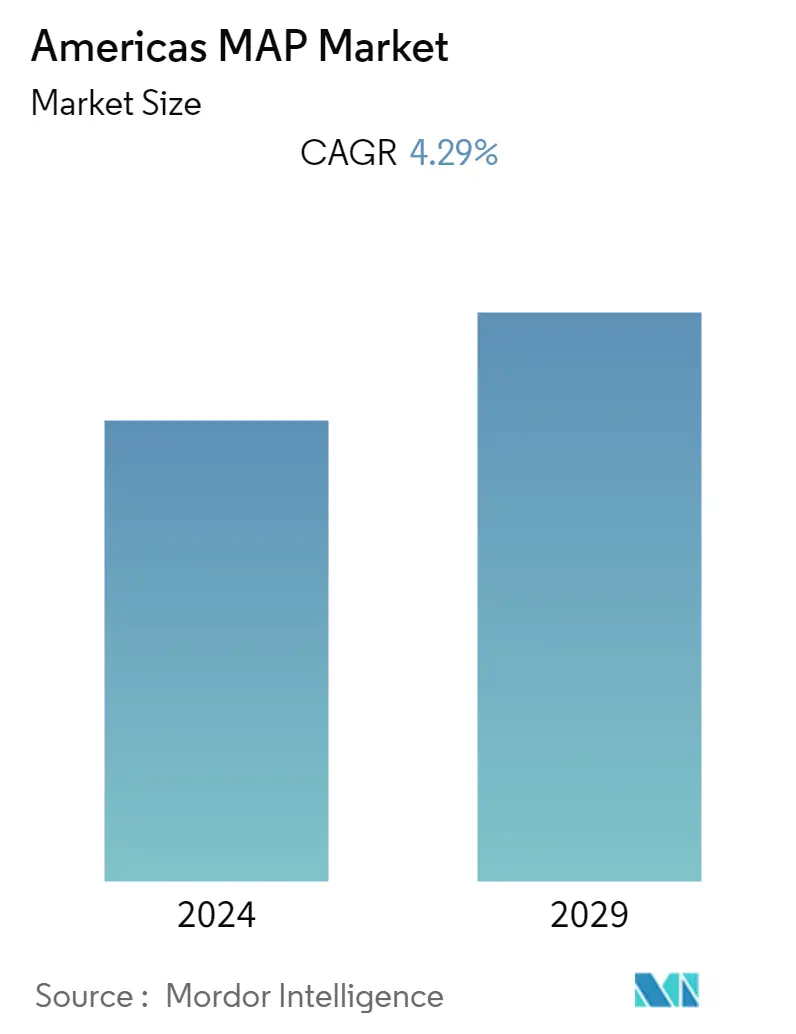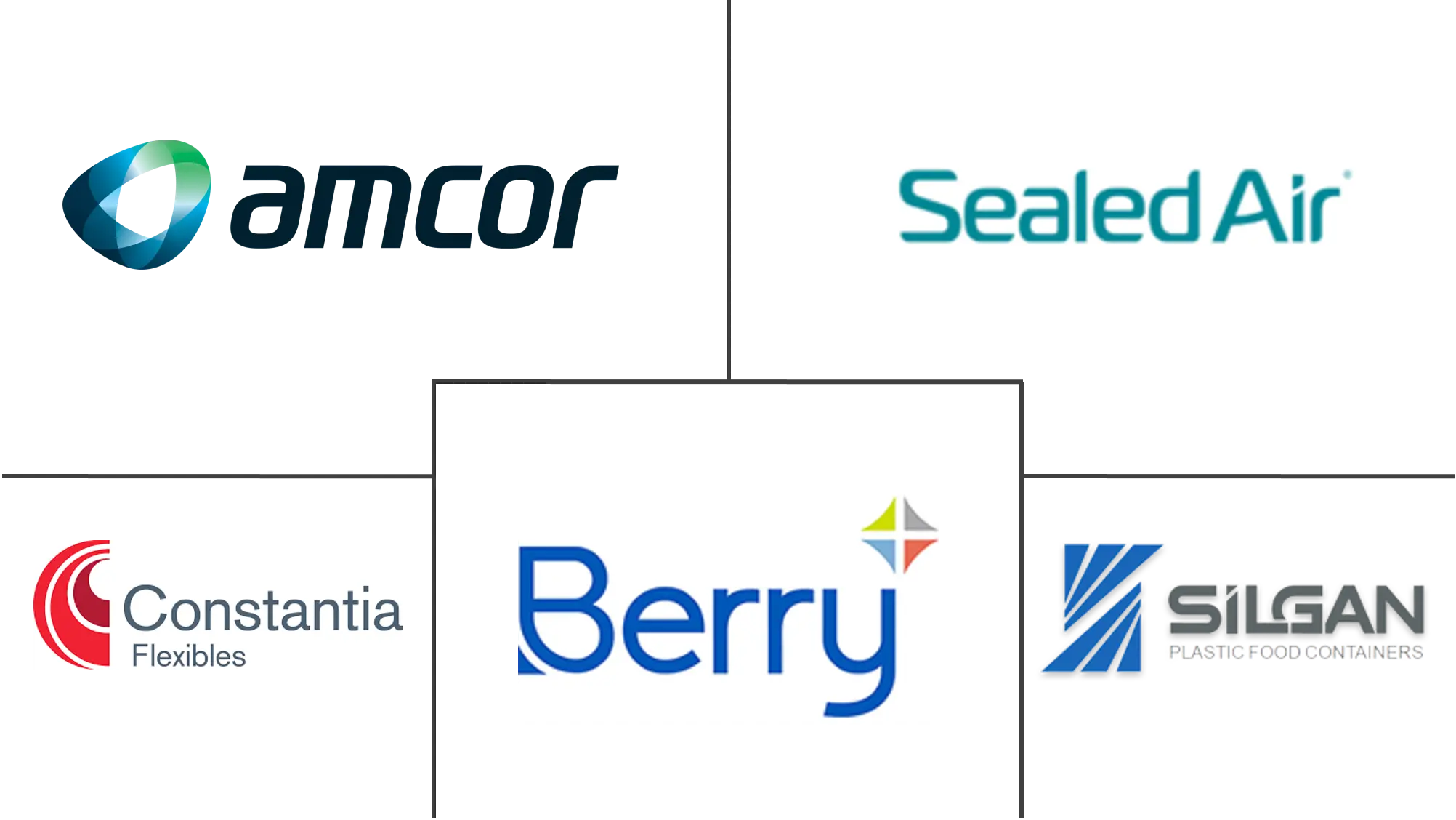Market Size of Americas MAP Industry

| Study Period | 2019 - 2029 |
| Base Year For Estimation | 2023 |
| Forecast Data Period | 2024 - 2029 |
| Historical Data Period | 2019 - 2022 |
| CAGR | 4.29 % |
| Market Concentration | High |
Major Players
*Disclaimer: Major Players sorted in no particular order |
Americas Modified Atmosphere Packaging Market Analysis
The Americas Modified Atmosphere Packaging (MAP) Market was valued at USD 6.06 billion in 2020 and is expected to reach USD 7.79 billion by 2026, registering a CAGR of 4.29% during the forecast period (2021 - 2026). Modified Atmosphere Packaging (MAP) is used to packaging meats, fruits, vegetables, and other consumable goods. Cheese, fresh pasta, ready meals, and seafood also benefit from MAP. MAPs ability to decrease the amount of oxygen inside the package reduces oxidation, leads to the elimination of the cause of discoloration, off-flavors, and textures.
- Considering, fresh fruits and vegetables, the air of packaging is replaced with atmospheric gases different in proportion. Usually, oxygen, carbon dioxide, and nitrogen are majorly used. Also, the choice and ratio of gases get dependent upon the material being packed. For instance, coffee beans release Carbon Dioxide when they are roasted, and without the use of MAP, the beans need to cool down before being packaged; else, the packaging would burst open.
- Moreover, developments in such technologies are significantly driven by the need for quality preservation, improvement in safety, and reduced postharvest losses waste. Therefore, such processing technologies aid in the reduction of costs and product quality.
- New initiatives to improve the sustainability profile of flexible packaging are being increasingly addressed in the region. These include technologies to drive recycling and collection and sortation of flexible materials, investigate new materials including compostable or bio-based structures, enhance processing technologies that extend shelf life and freshness, and increase consumer participation.
- For instance, programs such as Wrap Recycling Action Program (WRAP) allows the collection of polyethylene (PE) wraps to be recycled with plastic grocery store bags. Then, the How2Recycle label alerts consumers about flexible packaging formats.
Americas Modified Atmosphere Packaging Industry Segmentation
- Modified atmosphere packaging (MAP) is also known as gas flushing, protective atmosphere packaging, or modified oxygen packaging caters to using plastic or polymeric films to enclose fresh produce that adheres to respiration and transpiration-based changes in the atmosphere surrounding a commodity.
- Further, microbial growth leads to changes in texture, color, flavor, and nutritional value of such products. Therefore, the storage of fresh produce in a modified gaseous atmosphere enables the protection of quality whilst extending the shelf life, as a result of slowed chemical and biochemical deteriorative reactions.
- The scope of the study, thus, highlights materials and applications such as Polyethylene (PE), Polypropylene (PP), to name a few and Fruits, Vegetables, etc. respectively across North, Central, and South America.
| Material | |
| Polyethylene (PE) | |
| Polypropylene (PP) | |
| Polyvinylchloride (PVC) | |
| Other Materials |
| Application | |||||||
| |||||||
| Vegetables | |||||||
| Poultry, Seafood, and Meat Products | |||||||
| Bakery and Confectioner | |||||||
| Other Applications (Dairy, Coffee Roaster, Cannabis, Transportation and Logistics, and others) |
| Geography | |||||
| |||||
|
Americas MAP Market Size Summary
The Americas Modified Atmosphere Packaging (MAP) Market is experiencing steady growth, driven by the increasing demand for packaging solutions that enhance the shelf life and quality of perishable goods. MAP technology is widely utilized for packaging a variety of products, including meats, fruits, vegetables, cheese, fresh pasta, ready meals, and seafood. By replacing the air inside the packaging with a controlled mixture of gases such as oxygen, carbon dioxide, and nitrogen, MAP helps to reduce oxidation, preventing discoloration, off-flavors, and texture changes. This technology is particularly beneficial for products like coffee beans, which release carbon dioxide during roasting, necessitating careful gas management to avoid packaging failures. The market is also witnessing advancements aimed at improving sustainability, with initiatives focused on recycling, compostable materials, and extending product freshness.
The United States plays a significant role in the Americas MAP market, driven by the rising demand for processed and perishable food packaging that offers convenience and reduces food waste. The country faces substantial food wastage due to inadequate packaging, prompting the adoption of MAP solutions to preserve the quality of fresh produce. Key players in the market, such as Sealed Air, Amcor Plc, and Berry Global Inc, are actively developing innovative MAP products to meet these demands. The market is moderately consolidated, with a few regional vendors holding a majority share, while both global and regional players are expanding their presence through strategic initiatives. Recent developments include the introduction of specialized MAP trays and scented packaging solutions, highlighting the ongoing innovation within the industry.
Americas MAP Market Size - Table of Contents
-
1. MARKET DYNAMICS
-
1.1 Market Overview
-
1.2 Market Drivers
-
1.3 Market Restraints
-
1.4 Industry Attractiveness - Porter's Five Force Analysis
-
1.4.1 Bargaining Power of Suppliers
-
1.4.2 Bargaining Power of Buyers/Consumers
-
1.4.3 Threat of New Entrants
-
1.4.4 Threat of Substitute Products
-
1.4.5 Intensity of Competitive Rivalry
-
-
1.5 Assessment of Impact of Covid-19 on the Industry
-
-
2. MARKET SEGMENTATION
-
2.1 Material
-
2.1.1 Polyethylene (PE)
-
2.1.2 Polypropylene (PP)
-
2.1.3 Polyvinylchloride (PVC)
-
2.1.4 Other Materials
-
-
2.2 Application
-
2.2.1 Fruits
-
2.2.1.1 Grapes
-
2.2.1.2 Melons
-
2.2.1.3 Citrus
-
2.2.1.4 Berries
-
2.2.1.5 Other Fruits
-
-
2.2.2 Vegetables
-
2.2.3 Poultry, Seafood, and Meat Products
-
2.2.4 Bakery and Confectioner
-
2.2.5 Other Applications (Dairy, Coffee Roaster, Cannabis, Transportation and Logistics, and others)
-
-
2.3 Geography
-
2.3.1 North America
-
2.3.1.1 United States
-
2.3.1.2 Canada
-
2.3.1.3 Mexico
-
-
2.3.2 Central and South America
-
2.3.2.1 Brazil
-
2.3.2.2 Rest of Central & South America
-
-
-
Americas MAP Market Size FAQs
What is the current Americas MAP Market size?
The Americas MAP Market is projected to register a CAGR of 4.29% during the forecast period (2024-2029)
Who are the key players in Americas MAP Market?
Amcor PLC, Sealed Air Corporation, Berry Global, Inc., Silgan Plastic Food Containers and Constantia Flexibles are the major companies operating in the Americas MAP Market.

